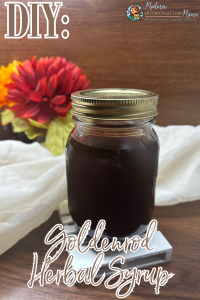By Sarena-Rae Santos, Natural Health Blogger
Whether you’re looking for relief this allergy season or have a surplus of goldenrod growing in your yard, this recipe is one you won’t want to pass up. If you read our Goldenrod Herbal Profile, you’d know goldenrod is a bright yellow flower of the Compositae family jam-packed with health benefits like:
- Antioxidant properties
- Anti-inflammatory properties
- Wound-healing properties
- Anti-aging properties
- May promote heart health
- May improve urinary tract health
- May aid in weight loss
- Anticancer properties
Why wouldn’t you want to make a simple herbal syrup from such a beneficial plant? Use it to sweeten herbal iced tea, pour on top of pancakes, or even use a spoonful of syrup to help the Sinus Saver go down. No matter what you’re using it for, the best part is it’s ready the same day, unlike our Goldenrod-Infused Honey, which steeps for four weeks.
Goldenrod Herbal Syrup
Ingredients & Materials:
- 1 ½ cups filtered water
- ½ cup dried goldenrod or 1 cup fresh goldenrod
- 1 cup of honey (I used raw honey)
- 16 oz. Mason jar
Directions:
Step 1: Combine ½ cup of goldenrod or 1 cup of fresh goldenrod and 1 ½ cups of filtered water in a saucepan.
Step 2: Bring the water and goldenrod to a boil before lowering the temperature and letting it simmer for 30 minutes (this process is a decoction water extraction). After simmering, the liquid level should have reduced to roughly 1 cup.
Step 3: Strain the liquid before adding it back to the saucepan.
Step 4: Allow the decoction to cool down before adding equal parts (1 cup) of honey to the decoction while it’s still warm (adding while it’s hot could result in losing some of the honey’s medicinal properties). Be sure to mix the honey into the decoction until the honey is dissolved.
Step 5: Set the syrup aside to cool down the rest of the way before pouring the honey into an airtight container for long-term storage.
Usage & Storage: Take 1-2 teaspoons up to three times a day (I love it added to tea). It will last about one month when stored in the refrigerator. If you notice a rancid smell or visible mold at the top, it has gone bad.
Disclaimer: This post is not intended as medical advice. These statements have not been evaluated by the FDA, and nothing in this post is intended to diagnose, treat, or cure anything. If you have questions, please do your own research or seek advice from a health professional.


